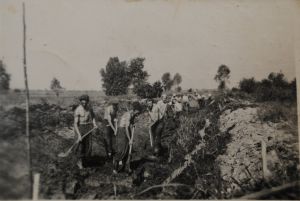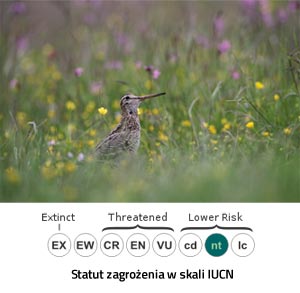Threats
26 luty 2013
Causes of the drastic reduction of the area of distribution of the great snipe in Europe
 No later than in XIXth century Europe the great snipe was a common resident of vast fens and flood-meadows in river valleys. It was also observed in Denmark, Germany and western Poland. Technical development, intensification of farming and associated large-scale drainage of wetland areas have led to a complete extinction of the great snipe in Western European countries, as well as in lowland regions of Scandinavia. The drastic decline of the species' population results, in addition, from a very narrow tolerance limits with respect to various environmental factors, which distinguishes the great snipe among other charadriiform birds. Being a specialist both in terms of its diet, as of its habitat, it has become particularly vulnerable to get extinct.
No later than in XIXth century Europe the great snipe was a common resident of vast fens and flood-meadows in river valleys. It was also observed in Denmark, Germany and western Poland. Technical development, intensification of farming and associated large-scale drainage of wetland areas have led to a complete extinction of the great snipe in Western European countries, as well as in lowland regions of Scandinavia. The drastic decline of the species' population results, in addition, from a very narrow tolerance limits with respect to various environmental factors, which distinguishes the great snipe among other charadriiform birds. Being a specialist both in terms of its diet, as of its habitat, it has become particularly vulnerable to get extinct.
The exceptional reproductive habits of the great snipe (lekking behaviour) have made it an easy prey for hunters, which can certainly be regarded as another important factor in its extermination. This problem was noted already in 1882 by the renowned Polish zoologist Władysław Taczanowski, who wrote in his book "The Birds of Our Country":
 "Shooters, benefiting from this, place their booths next to the lekking sites and often shoot a couple of individuals in one shot; the sound silences them for a moment, but if one does not reveal themselves, they will soon start the display again. Snares made out of hair are also being set, which allow grabbing them out to the last individual.
"Shooters, benefiting from this, place their booths next to the lekking sites and often shoot a couple of individuals in one shot; the sound silences them for a moment, but if one does not reveal themselves, they will soon start the display again. Snares made out of hair are also being set, which allow grabbing them out to the last individual.
(...)
These are the ways they are being exterminated in our area, and that is right in the time when they should be protected, and mainly for this reason their numbers are noticeably declining"
Today's threats
Habitat loss
In Poland, in the few sites where great snipes have still survived, their most important threat is the loss of breeding habitats. Until recently, farmers used to employ river valley extensively as meadows and pastures, which was favourable for wetland birds. Along with the decline in scything and the almost complete decline in horse pasturage, meadows faced the problem of becoming overgrown with reed and shrubs.
Habitat eutrophisation
Eutrophisation is a process of ecosystem enrichment in nutrients (biogenic elements – nitrogen and phosphorus), which leads to a trophic rise, that is an increase in the habitat's fertility. It results in a faster development of vegetation that is followed by an accelerated succession and fast overgrowth of open habitats. In the case of the great snipe's biotopes an increased eutrophisation is in the first place caused by the destruction of the natural hydrological equilibria in river valleys (overdrainage, shortening of spring floods) and by the influx of biogenic elements from the river's drainage area (chemical and natural fertilizers, communal sewage).
For these reasons our most important task today is to prevent the negative outcome brought to the natural environment by drainage and meliorations of wetland areas, although, in spite of all the efforts, the problem still exists in our country. Even in protected areas meliorations, deepening of river beds and river regulations are still being carried out. Only in the period of 2010-2012 as much as 9000 km of watercourses have been "renovated", many of which were located in the protected areas of Natura 2000 (data from WWF Poland).
Bird flushing
Great snipes are not being hunted in our country anymore (which was unfortunately not abandoned in Russia). The unusual reproductive system and the status of a "rarity" of the great snipe attracts, however, a new type of "hunters" equipped in cameras, binoculars and telescopes, who often crave to see this exceptional bird by all means. Certainly their motivation is very different from the typical hunters, nevertheless accidental and unintentional startling of the bird may, when occurring on a large scale, lead to a decline in number of leks.
For this reason, as part of our Project, we plan to streamline the tourism and to construct an observation tower nearby the popular lek in the upper Narew River Valley, which is often visited by these "hunters".
Species conservation status
Poland is, among all EU countries, particularly responsible for maintaining the favourable conservation status of the great snipe, because 27.7% of the population inhabiting the EEC is nesting in this country (Wilk et al. 2010).
Species conservation status
 International Union for Conservation of Nature (IUCN): Near Threatened (NT)
International Union for Conservation of Nature (IUCN): Near Threatened (NT)BirdLife International: SPEC 2
AEWA Agreement: Annex II
Conservation status in Europe:
(V) Vulnerable
Birds Directive: Article 4.1, Annex I
Bern Convention: Annex II
Bonn Convention: Annex II
Species conservation in Poland: strictly protected, requiring active conservation (Dz. U from 2004, No 220, passage 2237)
Polish Red Data Book of Animals (2001): VU vulnerable species


